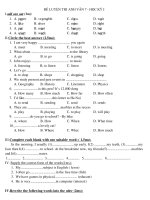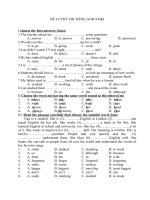Bai luyen thi anh van dai hoc 2016 lesson 27
Bạn đang xem bản rút gọn của tài liệu. Xem và tải ngay bản đầy đủ của tài liệu tại đây (116.24 KB, 3 trang )
LESSON 27 – June 2st , 2016
I. WORD FORMS. Use the word given in capitals below the text to form a word
that fits in each gap. There is an example at the beginning (0).
TEACHING CHILDREN AT HOME
It is (0) compulsory for children to have an education, but you may find it (1)........that
the teaching doesn't always have to take place in the school building. As long as they
have the (2)......paper (3)......, parents themselves can teach their children at home. They
may make the (4)......to do this because they are (5).......with a particular school, or
because they feel that they have more (6).......of their own child's needs than teachers at
school. However, there may be (7)......of parents who make this (8)......because some
people feel that children who are taught at home find it difficult to mix (9).......with
young people of their own age. However, (10).......of the idea disagree with this. They
think it is a better way of teaching children what is really important.
0. COMPEL 1. SURPRISE 2. NECESSITY 3. QUALIFY 4. DECIDE
5. HAPPY 6. KNOW 7. CRITICIZE 8. CHOOSE 9. SOCIAL 10. SUPPORT
II. KEY-WORD TRANSFORMATION.
0. Chloe would only eat a pizza if she could have a mushroom topping.
ON
Chloe....................................a mushroom topping when she ate a pizza.
1. Even if she runs really fast, Tina won’t get to school on time.
HOW
No ................................................... Tina won’t get to school on time.
2. Penny was unwilling to admit that the accident had been her fault.
BLAME
Penny was..................................................for the accident.
3. Clarice’s mother told her not to spend the money under any circumstances. MUST
‘Whatever..................................................that money, Clarice,’ said her mother.
4. Joe was very surprised to see Melanie walk into the room.
TAKEN
Joe ..................................................Melanie walked into the room.
5. In the office, Tom is responsible for all aspects of the updating of the company's
website.
OVERALL
In the office, Tom has....................the company’s website up to date.
6. It’s quite common for students at the school to go on to win Olympic medals.
MEANS
It’s .........................for students at the school to go on to win Olympic medals.
III. READING. Read the text below and choose the answer (A, B, C or D) which
you think fits best.
When engineer Tsutomu Takada lost his job, he decided to make a complete change in
his life. He took off his business suit and put on an apron - and started a course to
became a chef. ‘I had always dreamed of doing this, even when I was an engineer.’
says Takada. ‘And now, here I am,’ he says with a laugh.
He is a student at Tokyo’s Sushi University. This is the only university in Japan which
is devoted entirely to teaching the art of sushi. What is 'sushi'? It is Japan’s famous dish
of raw fish, dried seaweed and rice soaked in vinegar. Traditionally it takes decades of
training to become a sushi chef, but Sushi University trains chefs in one year.
As well as providing quick retraining, the university’s approach reflects a growing
change in Japanese society - a move away from the traditiona ways of doing things.
Phạm Thái Bạch Mai
‘Society has changed,’ sighs university principal Katsuji Konakai, who started as a
sushi apprentice more than sixty years ago.
‘People today wouldn’t put up with the tough training I had. When I made mistakes,
my teacher hit me on the head with his knife handle!’
Sushi hasn’t always been a matter of studying hard and being hit on the head. It
started in ancient China, where people preserved fish by packing it in rice and salt.
They did not eat the rice. It is said that this process probably came to Japan between
300 BC and AD 300. Adventurous Japanese cooks began to serve the pickled fish
together with vinegared rice. This combination of rice and fish was called 'sushi'.
The most important thing about sushi is that it has to look attractive. In fact, the most
carefully prepared sushi meals can cost hundreds of dollars! There are 45,000 sushi
businesses in Japan today, including take-away, as some people like to eat it for lunch
in their offices. There are also cheap self-service restaurants, where customers sit at a
counter which has different coloured plates with different types of sushi on them. These
plates move around the counter on a conveyor belt, and customers choose the sushi
they want to eat. When they have finished eating, the waitress counts the coloured
plates and works out the bill.
Mr Konakai has made sushi for Japan's emperor. He says sushi preparation is an art,
but he also believes that Sushi University’s intensive course is necessary.
‘Of course people complain this is not the way to do it,’ he says, ‘but we tried to make
it easier for those who wanted to learn about sushi, and for those who want to take it
overseas.’ Many of the students already have jobs lined up in places like Australia,
Italy and Singapore.
But the course is really just the beginning for the new chefs. According to Mr Konakai
it takes five, ten or even twenty years to become a top-notch sushi chef. ‘To make good
sushi, you have to have skill but you also need a warm heart,’ he says.
1. What made Tsutomu Takada start training as a sushi chef?
A. He wanted to fulfil an ambition.
B. He didn't want to work in an office.
C. He didn't know what else to do.
D. He thought he would make a lot of money.
2. Why is Sushi University so revolutionary?
A. It has unusual teaching methods.
B. You have to wait a long time to get into a course.
C. It only offers courses in sushi preparation.
D. You can only study there for a short time.
3. What does Katsuji Konakai say about the old training methods?
A. They are no longer acceptable.
B. They were too violent.
C. They were too traditional.
D. They were too quick.
4. Who was responsible for the invention of sushi?
A. People who caught the fish.
B. The Chinese people.
C. Japanese chefs who used the rice.
D. People who wrote about the history of cooking.
Luyện Thi Đại Học 2016 (27)
5. What is the main feature of contemporary sushi?
A. It is always expensive.
B. It is very popular.
C. It must look nice.
D. It is sold as a take-away.
6. What does Mr Konakai think about Sushi University?
A. It provides courses that are needed.
B. The training is too intensive.
C. It stops students having to study abroad.
D. The methods used in teaching are not right.
IV. CLOZE-TEST. Read the text below and decide which answer (A, B, C or D)
best fits each gap. There is an example at the beginning (0)
THE HARD SELL
Most companies spend a large (0) proportion of their budgets persuading us to buy
their products, and it is their (1)....... executives who have to decide how to make
consumers aware of new products. To do this, they usually set up an advertising
(2)......of some kind. Generally, (3)......a new product involves TV and radio
commercials, and there may also be large advertisements on (4)......along motorways
and major roads.
In the past, companies employed people to sell the product (5).........but nowadays
there is a far more popular technique which uses the telephone, staff in large callcentres telephone potential (6)....... , tell them about the product and try to convince
them that it is worth buying. Another technique is to (7)......the new product by post.
The company sends colourful (8).....to every house even though people haven't asked
for them. They are so unpopular that people call them (9).....mail - and even though
they may contain free (10).......or discount vouchers, many people just put them straight
into the rubbish bin!
0. A. section
B. proportion
C. division
D. fraction
1. A. selling
B. publicity
C. marketing D. propaganda
2. A. programme
B. campaign
C. approach
D. operation
3. A. starting
B. commencing
C. launching D. beginning
4. A. hoardings
B. boards
C. displays
D. screens
5. A. in person
B. to face
C. at hand
D. on show
6. A. shoppers
B. investors
C. buyers
D. customers
7. A. promote
B. sponsor
C. support
D. demonstrate
8. A. catalogues
B. prospectuses
C. reviews
D. journals
9. A. rubbish
B. garbage
C. junk
D. waste
10. A. samples
B. tests
C. pieces
D. bits
V. ERRORS IDENTIFYING. There are mistakes with prepositions and particles
in some of these sentences. Find the mistakes and correct them.
1. This electronic dictionary is just what you need for help you when you travel abroad.
2. This torch key ring really comes in handy when you are trying to open your door in
the dark.
3. Microwave ovens are very useful to people who don't have much time to cook.
4. This is the perfect gift to the woman who has everything.
Phạm Thái Bạch Mai
5. That sofa would be ideal for a spare bed when guests come to stay.
6. A dishwasher is very convenient for large families with plenty of plates and cutlery.
7. This hairdryer is designed for convert itself into a travel iron.
VI. ONE-WORD GAP -FILL. Read the text below and think of ONE word that
best fits each gap. There is an example at the beginning (0).
MOMENTS OF PERFECTION
My cousin had a terrible experience (0) [WHEN] she was working for a big
advertising agency. Her boss had ordered (1).......to think up a new slogan for a very
important client. After a week, my cousin had not (2).......able to think of any good
slogans so she went to her boss and apologised (3).......being so slow. He warned her
(4)......if she didn't think of something in the next twenty-four hours the company might
lose (5).......client and that it would be her fault. My cousin stayed awake (6)........ night
trying to think of a catchy slogan. She was about to phone her boss and admit that she
(7).......not thought of anything when her flatmate suggested that she should try
listening (8)......some of her favourite records for inspiration.
(9).......first, nothing seemed very inspiring (10).......then she heard a song called
Simply the best. My cousin rang her boss and told (11).......that she thought that it
would make a great slogan. He accused her (12)......having copied another very famous
advertising campaign in which the same slogan had been used.
VII. COLLOCATIONS. Choose the best alternatives in the following sentences.
1. This jacket was a......bargain. It was reduced from £100 to £25.
A. big
B. real
C. important D. complete
2. I didn't have much cash so I decided to pay......cheque.
A. in
B. on
C. with
D. by
3. There was a really......queue outside the cinema.
A. large
B. long
C. wide
D. broad
4. I always wait to buy my clothes.....the sales.
A. on
B. with
C. to
D. in
5. We try to budget......all the unexpected expenses that can come up.
A. with
B. for
C. to
D. on
6. I got a big discount...... this table because it had a scratch on it.
A. with
B. for
C. to
D. on
7. I asked them but they wouldn't......me a refund.
A. give
B. do
C. make
D. have
8. This DVD player doesn't work. We'll have to......it back to the shop.
A. return
B. bring
C. have
D. take
9. Do you have these trousers......grey?
A. in
B. on
C. for
D. at
10. The men's clothes are......the fourth floor.
A. in
B. on
C. for
D. at
(*||*)
ᴗ
Luyện Thi Đại Học 2016 (27)
ANSWER KEY TO LESSON 27
I. WORD FORMS: 1. surprising 2. necessary 3. qualifications 4. decision 5. unhappy
6. knowledge 7. critics / criticism 8. Choice 9. socially 10. Supporters
II. KEY-WORD TRANSFORMATION.
0. Chloe insisted ON having a mushroom topping when she ate a pizza.
1. matter HOW fast she runs:
fixed phrase 4- inversion
2. not willing/unwilling to take the BLAME:
lexical change + collocation
3. you do, you MUST not spend:
fixed phrase + modal verb
4. was TAKEN completely by surprise when: modified adjective to modified verb
collocation
5. OVERALL responsibility for keeping:
adjective to noun phrase
6. by no MEANS uncommon:
fixed phrase negative adjective
III. READING. 1 A 2 C 3 A 4 C 5C 6A
IV. CLOZE-TEST. 1. C - 2. B - 3. C - 4. A - 5. A - 6. D - 7. A - 8. A - 9. C - 10. A
V. ERROR CORRECTION: 1 need for to 2 √ 3 useful to for 4 gift to for 5. ideal for
as 6 √ 7 designed for to
VI. ONE-WORD GAP-FILL. 1. her 2. been 3. for 4. that 5. their 6. all 7. had 8. to 9.
At 10. but 11. him 12. of
VII. COLLOCATIONS 1. B 2. D 3. B 4. D 5. B 6. D 7. A 8. D 9. A 10. B
Phạm Thái Bạch Mai
Luyện Thi Đại Học 2016 (27)









